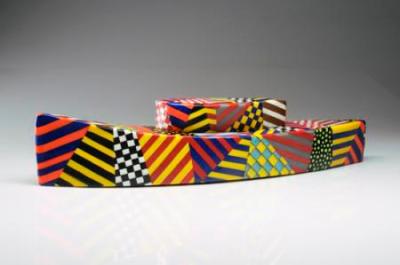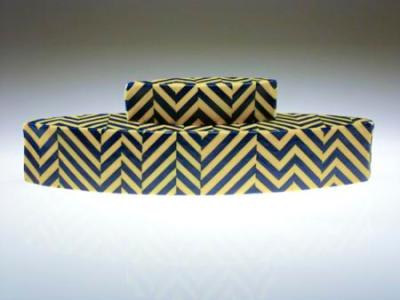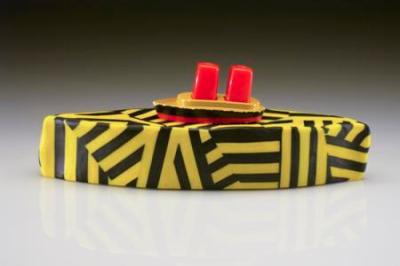 Richard Marquis, Razzle Dazzle Boat, 2010
Richard Marquis, Razzle Dazzle Boat, 2010
In Richard Marquis’ exhibition “Outbreaks of Obfuscation”, which opened June 1st at the Bullseye Gallery in Portland, Oregon, colorful and bizarre glass sculptures draw from World War I marginalia alongside tongue-in-cheek paintings adorned with a type of fractal described by Polish mathematician Waclaw Sierpinski in 1915 (the “Sierpinski triangle”). If you add to that Marquis’ sculptures of teapots and eggs on wheels, the total effect of the works is of a cartoon world: vibrant and eccentric, but sustained by a confident internal logic.
The “obfuscation” of the exhibition’s title may refer to Marquis’ deliberate visual referencing of esoteric points of early 20th-century history. Not that any historical understanding is necessary to enjoy works such as the several sculptures entitled “Razzle Dazzle Boat”, which reference a type of camouflage painted on British and American warships in World War I (and to a lesser extent, World War II). Invented by British painter Norman Wilkinson, “dazzle camouflage” (also known as “razzle dazzle” or “dazzle painting”) was meant to confuse enemy rangefinders by painting a ship in an irregularly patterned and colored mix of geometric shapes. While there was no consensus among the armies on how much the camouflage actually succeeded in distorting a ship’s size or movement, the painted warships were said to boost the morale of soldiers, in addition to providing an aesthetically stunning spectacle for the public when seen lined up together at docks.
 Richard Marquis, Razzle Dazzle Boat, 2008
Richard Marquis, Razzle Dazzle Boat, 2008
Marquis’ boats magnify the principle of dazzle camouflage: the sculptures are by turns more colorful, bombastic, and hypnotic than their historical models. Geometric slabs push up against one another, while lines streak in every direction, suggesting a self-contained field of energy and motion, impeding the linear progress inherent in the boat’s design. In another twist on the model, one of the sculptures, entitled “Razzle Dazzle Boat with Salt and Pepper Shakers” takes the framework of the razzle dazzle boat, but superimposes – you guessed it – a salt and pepper shaker on top, which is itself in the shape of a boat. Here, the historical aestheticization of a military object, which aimed at an illusory de-functionalization (in the eyes of the enemy), blends with the wholesome functionality of a kitchen-table object (and, it must be noted, a self-consciously cute one).
Such juxtapositions might lead one to suspect that Marquis intends a particular conceptual meaning or message, but the artist would in all likelihood resist that. In a profile appearing in Glass in Fall 2007, Marquis had this to say about his recent work: “Don’t read too much into it. It’s not that conceptual. I’ve tried to remove content from my work. My work is pretty much all form now, all aesthetics. I’m pretty much just trying to make cool shapes.”
 Richard Marquis, Razzle Dazzle Boat with Salt and Pepper Shakers, 2009
Richard Marquis, Razzle Dazzle Boat with Salt and Pepper Shakers, 2009
Perhaps, then, the “obfuscation” is also something of a joke directed at Marquis himself – an artist who maintains that his work is only about the immanence of form, but whose inspiration for form derives from a meaningful and specific historical content (and, in the case of the salt and pepper shakers, a real and historical use-value). In reality, there is nothing contradictory about the artist’s words and his technique. The razzle dazzle boats bear with them an obfuscated gesture, but this fact does not directly relate to the aesthetic experience of the works, in which the form itself fascinates and gives pleasure, while simultaneously suggesting its own import through a history of shared associations and meanings. Which is just to say, beyond the esoteric references, one encounters works of great vibrancy and technical expertise.
—Lee Gaizak Brooks
IF YOU GO:
Richard Marquis: Outbreaks of Obfuscation
June 1-July 24th, 2010
Bullseye Gallery
300 NW 13th Avenue
Portland, OR 97209
Tel: 503-227-0222
Website: www.bullseyegallery.com


